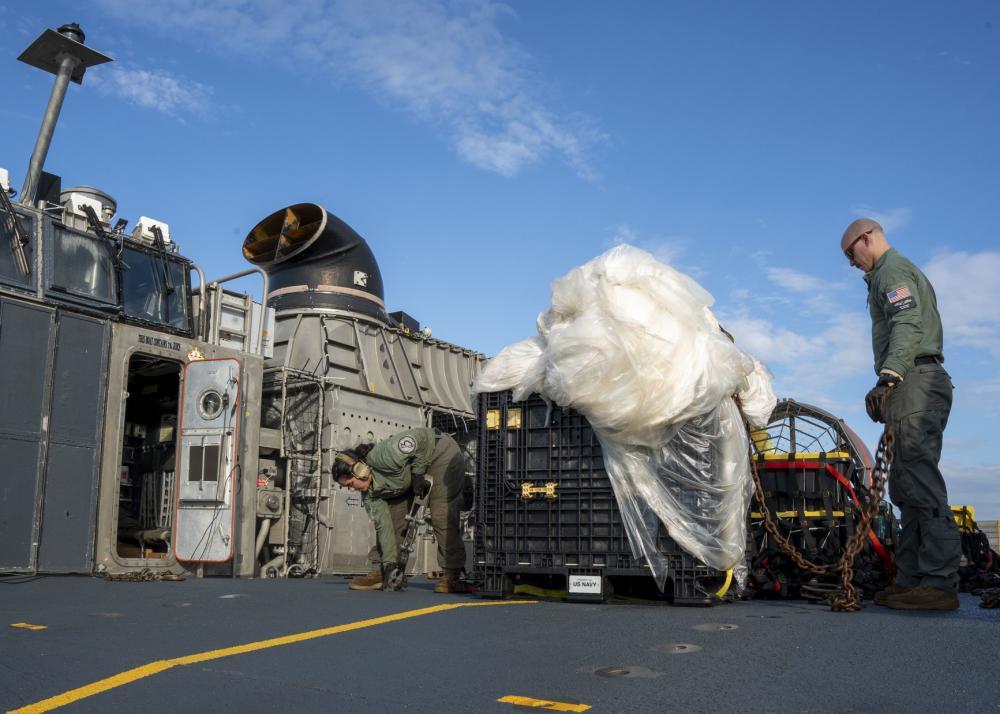
Sailors assigned to Assault Craft Unit 4 prepare material from a high-altitude balloon recovered in the Atlantic Ocean on Feb. 10.
President Joe Biden has ordered his national security team to begin a review of the policy implications of the series of sightings of unidentified objects that were then downed by U.S. fighter aircraft, as both U.S. and Canadian authorities attempt to recover debris and determine what the objects are.
U.S. fighters shot down a Chinese high-altitude surveillance balloon on Feb. 4. Then, over the course of three days (Feb. 10-12),they downed three other unidentified objects in Alaska, northern Canada and Lake Huron near Michigan. Debris from the latter three objects have not yet been recovered, as crews face treacherous sea ice, wilderness and deep waters in the locations.
National Security Council spokesman John Kirby told reporters Feb. 13 that Biden directed National Security Advisor Jake Sullivan to start the interagency review, calling for elements of the government to “redouble their efforts” to both understand and mitigate unexplained aerial phenomena (UAP). This comes after the Defense Intelligence Agency (DIA) and military services have conducted studies of UAP sightings, including a January report that outlined 163 sightings of balloons or balloon-like entities.
Biden also called on Defense Secretary Lloyd Austin, Secretary of State Antony Blinken and the DIA to share what they have learned with international partners because “this is an issue that affects everybody around the world,” Kirby says.
On Feb. 13, Chinese Foreign Ministry spokesman Wang Wenbin claimed the U.S. had flown its own high-altitude balloons over Chinese airspace more than 10 times since the beginning of the year. Kirby then said the claim is not true and the U.S. had not flown any craft over China within the atmosphere, but would not expand that claim to other territories that China claims as its own, including Taiwan and the South China Sea.
Since the Chinese balloon was spotted over the continental U.S. earlier this month, the North American Aerospace Defense Command (NORAD) has adjusted radar settings, lowering velocity gates to more closely scrutinize airspace and detect slower-moving objects, NORAD commander U.S. Air Force Gen. Glen VanHerck said Feb. 12.
U.S. Air Force Chief of Staff Gen. Charles Q. Brown, speaking during a Feb. 13 Brookings Institute event, said the sighting of the Chinese surveillance balloon was something that “got all of our attention” and required the adjustment of radar sensitivities to see things that normally would not be seen.
“But we don’t fully appreciate or understand exactly what we’re seeing, so as we progress through the recovery efforts for some of the things that we shot down, we’ll know more,” he says.
The latest objects had not been identified when they were shot down, though crews determined they did not pose a direct threat using weapons and were not manned. Identification has been difficult because it is hard to positively identify a relatively stationary object from a fighter jet flying hundreds of miles per hour, Kirby says.
Since the balloon was downed, U.S. officials have said similar objects have been tracked across 40 countries and five continents. This includes sightings by the U.S. military abroad.
Lt. Gen. Alexus Grynkewich, commander of U.S. Air Forces Central Command (AFCENT), told reporters Feb. 13 that his command in the Middle East has seen surveillance balloons in the region. They did not go near sensitive sites, but “we have seen them in the past transiting through the region.”
This includes an incident sometime last year when a Chinese high-altitude surveillance balloon moved through the region over water.
“We never got close to it because it was never a threat,” Grynkewich says.
AFCENT itself is interested in getting similar high-altitude surveillance balloons to improve its domain awareness by providing a “more persistent stare,” he says.

Comments